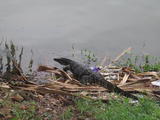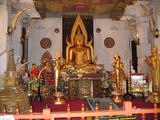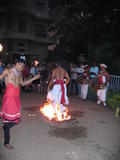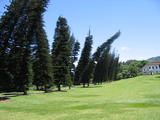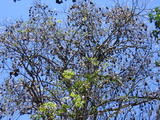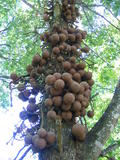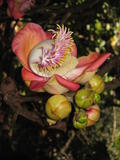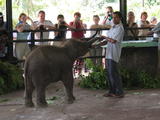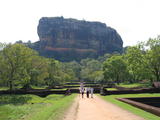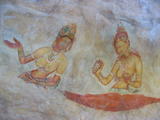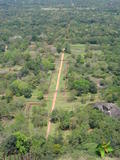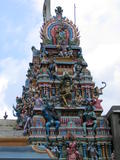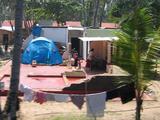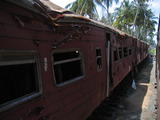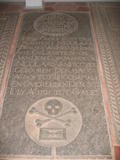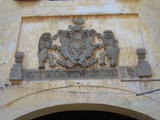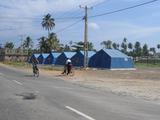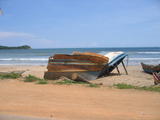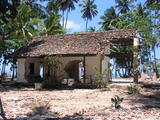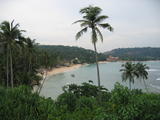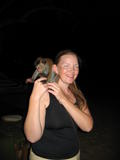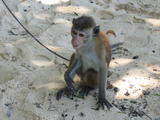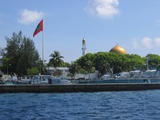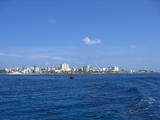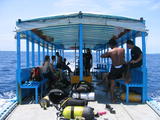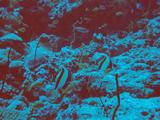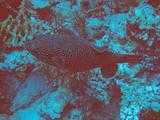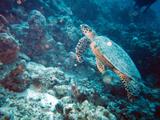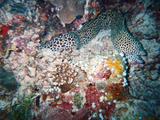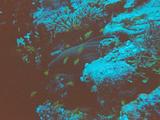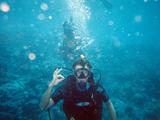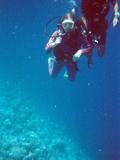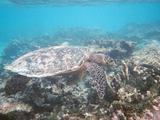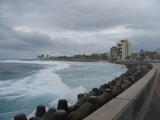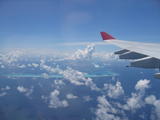| < < < Previous story | Next story > > > | |
The Trouble in ParadiseKathmandu, 05 June 2005
Contents:ChennaiOur Indian Airlines flight from Kuala Lumpur landed in Chennai, a city of 5 million people in southern India, formerly known as Madras. The plane was still slowing down as nearly every Indian in the plane stood up, opened up their overhead compartments, took out their oversized hand luggage and then just stood there, crammed in the aisle, while the plane was taxiing to the gate! Patience must not be their strong point. We had been forewarned by many other travelers about the difficulties of traveling in India, hence we felt prepared. With extremely low expectations we settled in a cheap hotel in the Triplicane area. Our first impression was that it was not all that bad. It was actually possible to walk a few meters without being bothered by someone. Granted, some things are a bit extreme. People defecate in the streets and others (or the same ones) live and sleep in those streets. Everything is dirty and badly maintained. We could not see for example if buildings were just old and crumbling due to lack of maintenance or if they had been damaged by the tsunami as even away from the coast the mess still looked the same. There was nothing very appealing to us in Chennai, the odd few things to visit were unimpressive, mainly it was just a big dirty city. Thankfully we found a flight to Colombo and on to Malé with Sri Lankan Airlines that would bring us back to Bangalore, center of India's IT industry, we would not have to return to Chennai. KandyWe were initially very impressed with Sri Lanka, due to the quality of their national airline and the efficient airport immigration. Kandy was our first destination and this is were our initial good impression was shattered into one thousand pieces. It seemed like every Sri Lankan, approached us to start a "friendly" conversation, which quickly turned out to be a commercial pitch or an attempt to get us to go somewhere so that they could get commission. In one case, two guys were pushing us to go to a show, it was all pretty friendly, but we told them that we were not going today but tomorrow as we already had other plans. Probably realizing that they were not going to make a commission off us they started a whole rant about how all Dutch people are the "same", it was rather offensive and certainly did not endear us to Sri Lankans. Kandy was not as impressive as it was made out to be, the lake is not that great, the air in the center is very polluted, the Temple of the Tooth is alright but then we have seen so many temples. We choose to go to the less commercial Kandyan dance show at the YMBA, making sure that no annoying, pushy and potentially offensive tout would get any commission off us. The show was quite a nice way to spend some time, it ended with a fire walk. In the nearby botanical gardens, there are lots of different plants but the most interesting thing may be all the bats that are hanging in the trees at the northern side of the park. As we were walking through the park looking at the bats, some guy comes up to us and starts "showing" them to us (I mean what does he think we are looking at), then takes a stick and starts to scare the bats "for us". We told the idiot to stop immediately but when we left he still had the guts to hold up his hand asking for money for his "services". We left his hand empty. In Sigiriya, in the cultural triangle north of Kandy, we were first confronted with the official discrimination against foreigners by the government of Sri Lanka. We had to pay 100, yes really one hundred, times more than Sri Lankans to visit the site. Certainly does not make you feel welcome in the country. Maintenance and restoration of the site is done thanks to support from foreign countries, which means that we are actually paying twice for the site with Sri Lankans just freeloading on us. At 20 USD per historic and natural site, we had chosen what is by certain accounts the most impressive site in Sri Lanka. Sigiriya however is visited in under 2 hours, the giant lion feet and cave paintings are interesting as is the view from the top, however the entire site is not more than ruins of which only the foundations are still visible. Compared to say Bagan, 10 USD once (you could spend a week there and still not see everything), or Angkor, 20 USD for one day (which is not enough time), 20 USD for something that is visited in under 2 hours seems rather steep! Since Sigiriya was supposedly the best the country had we decided not to waste any more money on overpriced sites in Sri Lanka. We hoped to see a nicer side of Sri Lanka at the Pinnawela Elephant Orphanage, but the usual discriminatory pricing occurred again (though less extreme). In the orphanage, guides encourage you to take a photo with an elephant and to touch one. Of course once this is done, they waste no time to ask for money (and we were already overcharged to enter the place)! I had hoped to see people who cared about elephants, but instead saw only people interested in extracting as much money as possible from foreigners using the elephants as a tool. The elephants were beaten with sticks and chased. At the river, where the elephants were taking a bath, they were horded together by the mahouts. One elephant's chain got stuck between the rocks, the poor thing pulled at the chain with his trunk and was visibly scared as an angry mahout ran towards him! Once the chain was loose the elephant ran as fast as it could. We are told the mahouts really love the elephants. Well I couldn't see that, but it was very clear that the mahouts love money. We were rather disappointed in Sri Lanka from what we had experienced until now. The people seemed shallow, their pretend friendliness was invariably just a means to extract money from us. It seemed like Sri Lanka was a great place to find out what it feels like to be a walking bag of money. Of course, it is the government of the "Democratic Socialist Republic of Sri Lanka", as the country anachronistically calls itself, that sets the example by ripping off foreigners with indecently high entry fees. What does this tell ordinary Sri Lankans? That foreigners are here to be milked out of as many Dollars as possible and that it is perfectly OK to overcharge a foreigner. It's a rotten atmosphere. Galle, Unawatuna and the TsunamiWe left for southern Sri Lanka taking the train to Colombo through the scenic mountains of central Sri Lanka followed by a train from Colombo along the coast to Galle. A few kilometers south of Colombo, the destruction caused by the tsunami was visible all around. The train line itself was destroyed but has since been rebuilt. Ruined houses, piles of bricks, a few walls still standing, sometimes a tent or wooden shack between the rubble, serving as temporary housing. Galle fort was still intact, the old walls had never served for their military purpose, but saved the lives of all those who were within the walls during the tsunami. Galle fort was built by the VOC (Dutch East India Company) in 1663. Sri Lanka was a Dutch colony until Napoleon invaded the Netherlands. The United Kingdom then took over the former Dutch colonies for safe keeping until Napoleon was defeated. However Sri Lanka was not returned to the Netherlands after the defeat of Napoleon. As the entire coast was destroyed we did not know what to expect of Unawatuna, which formerly was known as the most relaxed place on Sri Lanka's southern coast. On a day excursion from Galle, we found that indeed all buildings had been damaged or destroyed, but around one third had been reconstructed and were open for business. The only thing missing was other visitors. We decided to move to Unawatuna for a few days. Reconstruction was moving at a slow pace. The few businesses that were attempting to reopen were eager for business. Surprisingly one gets used to all the rubble. Everybody had a tsunami story to tell. Like the man who ran with his wife and two children, they managed to save each other by holding each other, when they returned to what was left of their home they found that even the family dog had somehow managed to survive. Another taken by the wave, managed to swim to a first floor balcony of a hotel were two guests pulled him in. Others told us that as the water receded before the wave came some people were already laying claim to the newly appeared land! A large part of the foreigners staying in Unawatuna were there on one of the many aid missions, and thankfully for the people and businesses of Unawatuna a few real tourists started to trickle in as well. We heard many stories of aid abuse, such as one guy who was sitting outside of his home smoking a joint while foreign aid workers were busy rebuilding it. Aid workers told us they had great difficulties extending their visas, something which is easy to do for normal tourists. Or worse, apparently a fishing boat, fishing nets and medicine was donated by a European charity to the fishermen in the region only to be seized by the navy (which now uses the boat). The nets and medicines locked up awaiting payment of "import duties". Many such stories do the rounds in Unawatuna, it is just too sad. Many people in Unawatuna do not know if they are allowed to rebuild their homes, as the government has decreed that no construction is allowed within 100 meters of a beach. Unfortunately the land they have is located within the given zone and if they rebuild they run the risk of the government tearing it down again! Some are taking the risk though. The rumor is that the government wants to appropriate the land to build a luxury resort in Unawatuna, because it has "the best" beach in Sri Lanka. We found Unawatuna more pleasant than Kandy and the people to be much more friendly. In spite of the tsunami, it was possible to relax, enjoy the food of some of the restaurants along the beach or go for a swim in the warm sea water. Though sometimes, after it rained, there was some garbage in the sea. MaldivesWe arrived at Malé Airport around 01:30, when we finally were done with customs and asking questions at the tourist information desk it was nearly 03:00. We were offered a hotel for the remaining half of the night in Malé for 40 USD (which is relatively cheap for the Maldives). But we decided to sleep at the airport instead and hop over to Malé in the morning to find some accommodation by ourselves. There were some benches on which we crashed. It was not too noisy to sleep. There was a little cafeteria and a shower as well as clean toilets. The airport being on an island in a country with a very low crime rate, we found all our luggage and shoes still by our side when we woke up. Nobody bothered us. Two fellow passengers on the plane, Robin and Jessica, followed our example and in the morning the four of us took the ferry to Malé. We met a local man on the street who offered us a room in his office for just 25 US Dollars per night. After visiting a few of the hotels we returned to his place and took the room as this was the most affordable accommodation of decent quality that we found. It was difficult to get any information about Malé beforehand, but once there, the town turns out to have quite a lot of facilities. Besides several good and affordable restaurants, a few Internet Cafés there is also a good dive shop on Malé itself. It is run by a Japanese lady called Uno, her prices are nearly half that of those the resorts charge and thankfully quite normal by world standards. Moreover she dives the same sites as the resorts do! Though Malé is somewhat expensive, compared to other South Asian countries, price levels are just a fraction of what they are on the resorts and choices for food are far greater. Although there is no alcohol, which is strictly banned outside of the resorts and more unfortunately no good beaches and reefs to swim or snorkel on (though there is a beach on the nearby island of Villingili). Strangely enough some residents of Malé have acquired sport cars, even though the speed limit is just 30 km/hour! Furthermore with a taxi costing just 15 Rufiyaa (less than 1 Euro), just think of how many rides you can get for the price of one sport car. It just does not make any sense to own a car at all! When arriving at the airport without a resort reservation, you will be able to find something on the spot from one of the many stalls outside the arrivals gate. However it seems wiser to first spend a day or two in Malé, to explore the capital and find some last minute cheaper deals through travel agents in town, taking care to check out the resort of your choice on the Internet. Resorts are not really our thing, but we choose to go to a resort for a 3 day period (out of the 12 days that we spent in the Maldives). We arranged our own transport at a fraction of the transfer costs normally charged by the resort. I found the resort pretty boring, except for the excellent house reef, where snorkeling was extremely good. There were stingrays, a shark, fish of every color, but the best was a turtle that did not swim away. I managed to observe that turtle for more than half an hour, sometimes it even swam towards me, until I finally left to go see something else. The turtle was tearing up dead coral, looking for food. At one point it must have found some fish eggs, because one small fish kept trying to bite it in the eye. The turtle just waved it away with his flipper. In the evenings, to counter the boredom, the resort organized some small event, such as the obligatory crab race. Which some people take surprisingly seriously, even taking other people's crabs! How pathetic. During our stay in Malé I went on 8 dives as well as some snorkeling trips and Maris did her first introduction dive. I have had the luck to see, giant morays, all kinds of other morays, some sharks, sea turtles, sting rays, a manta, lionfish, triggerfish, huge napoleonfish and many many other types of fish. I also dove through a cave and through the cabin of the Victory shipwreck! The latter was very exiting! The underwater world in the Maldives is definitely a big highlight of this island nation. That aspect as well as the resorts is unfortunately the only thing most tourists ever experience in the Maldives as most visitors go directly from the airport to their resort. There is much more to the Maldives and it turns out that there is some trouble in paradise! The president has been in power for 27 years. There are no opposition parties and those who criticize the government are either exiled or imprisoned. Because the Maldives has only 250,000 inhabitants not much attention is paid to the Maldives in the foreign media. The resorts are heavily taxed by the government, approximately 60% of their takings go to the government, but the people feel that this money is not spent on them. Every government building is "protected" by bunkers and armed guards. Surely they don't expect an imminent invasion? It seems that what these buildings are really being "protected" against is the people's anger that occasionally boils over! That said, the country is a lot better developed than its neighbors and living standards are much higher, but as one Maldivan told me, it could be so much better. If you would like to be notified or no longer want to be notified of our travel updates please e-mail me. e-mail Otto de Voogd PhotosKandyPinnawela Elephant OrphanageSigiriyaGalle, Unawatuna and the TsunamiMaldivesPractical Information
To my knowledge the information provided here was accurate
at the time of our visit. However time passes and things can change.
Visas
India: from Indian embassy in Yangon:
65 USD (40 USD + 25 USD for telex) the process takes one week.
The embassy in Yangon is a good place to apply. As not many people apply
there we never had to wait a long time.
Money
India: Many, but not all, ATMs work with foreign cards.
Travel
Airlines:
InternetIn both Sri Lanka and Maldives Internet is rather slow. In India we always found some Internet cafés with fast connections. CostsIndia - Rupee, approx. rates: 1 USD = 44 INR, 1 EUR = 56 INR
Airport taxi to Chennai center (Triplicane): 260 INR
Sri Lanka - Rupee, approx. rates: 1 USD = 100 LKR, 1 EUR = 128 LKR
Colombo International Airport -> Kandy by taxi: 3000 LKR (bargained down from 3700 LKR). The road with buses is a few 100 meters from the terminal but a taxi saves some time and hassle.
Maldives - Rufiyaa, approx. rates: 1 USD = 12.80 MVR, 1 EUR = 16.50 MVR
Ferry from Airport -> Malé: 10 MVR or 1 USD (20 MVR or 2 USD between 00:00 and 06:00)
| ||
| < < < Previous story | Next story > > > | |
New | About | Contact | Connect | Friends | Promotions | Copyright | Advertise

